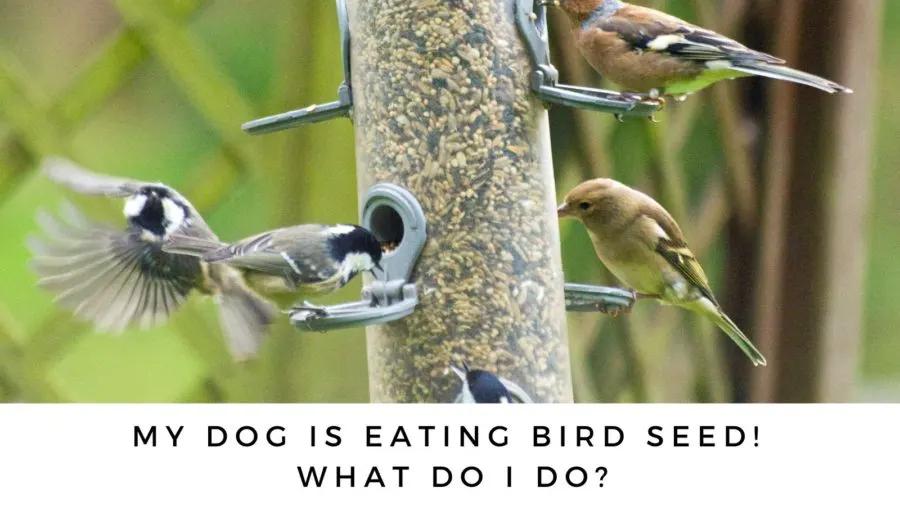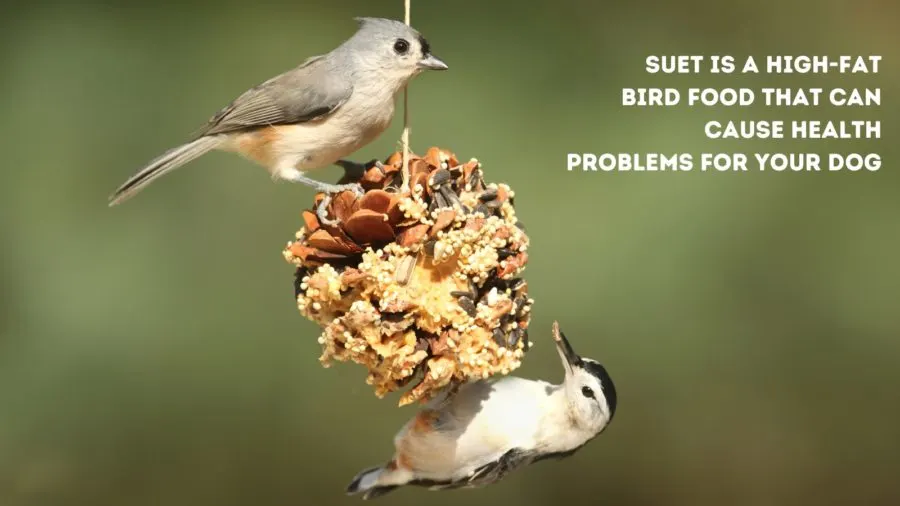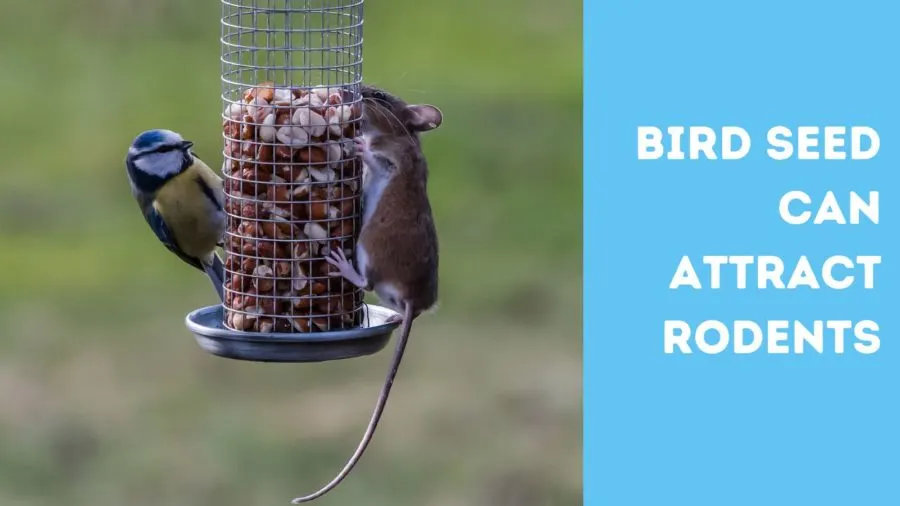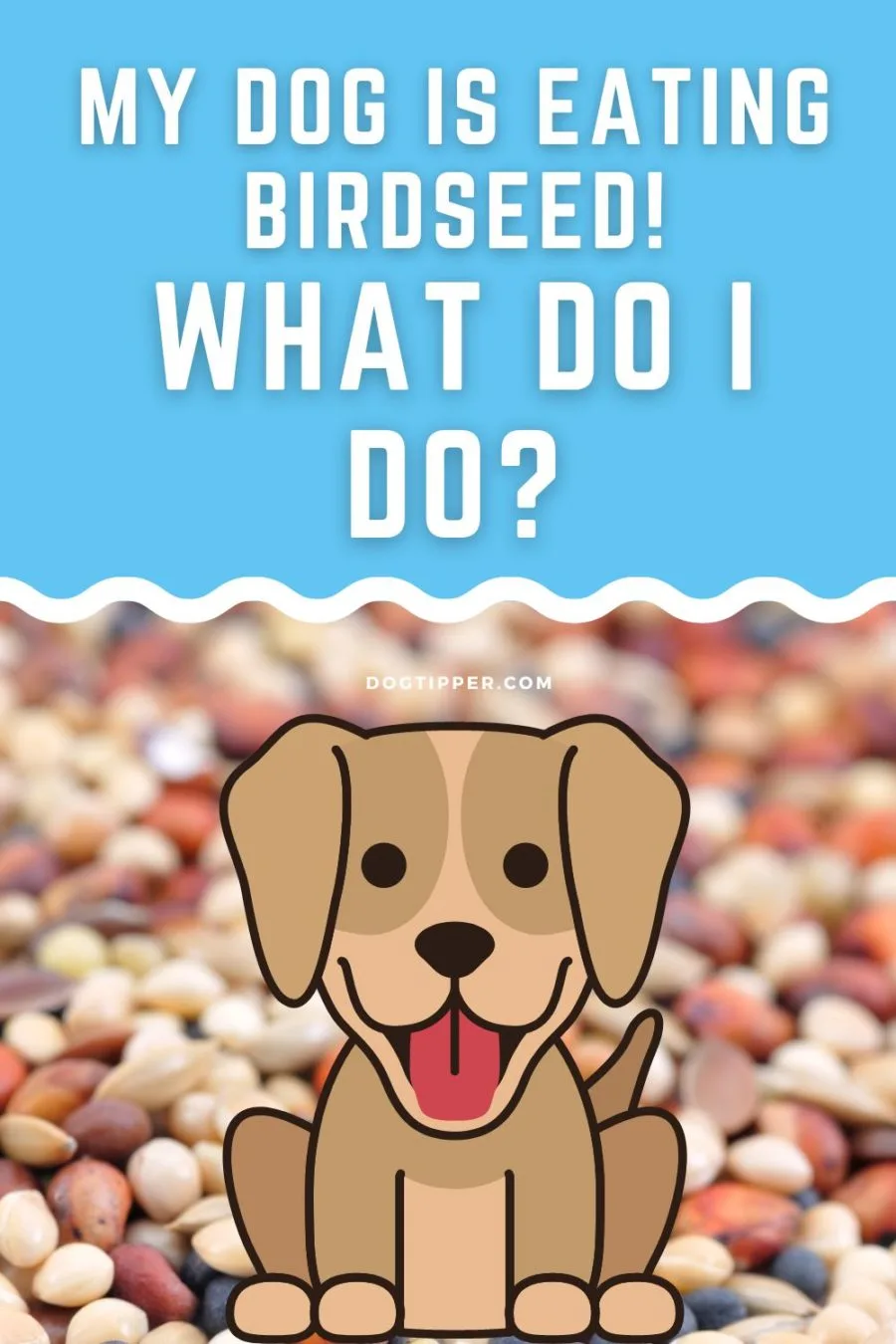Do you love to feed the birds? Like many dog lovers, we also enjoy filling our bird feeders and watching the birds around our home. We all know that it’s not uncommon for seeds (and maybe even suet) to fall to the ground beneath the feeder–and that seed can be attractive to dogs. If your dog is eating bird seed, either beneath the bird feeder or in your home, we’ve got veterinary advice on possible concerns as well as suggestions from dog trainers on how to stop your dog from eating bird seed.

First, The Good News
Did you see your dog grab a snack beneath the feeder?
Don’t panic.
Dr. Jamie Whittenburg, DVM, lead veterinarian at SeniorTailWaggers.com and Director of Kingsgate Animal Hospital, a full-service animal hospital in Lubbock, Texas, notes, “In the vast majority of cases, a dog eating bird seed is not a cause for concern. Dogs who eat a small amount of fallen bird seed from under a bird feeder may experience some gastrointestinal upset, including vomiting, stomach pain, and diarrhea.”
Of course, as with many concerns, there are always exceptions, times when dogs do experience more than upset tummy.
Danger of Moldy Seed
Dr Whittenburg explains, “There is a small chance of a more serious issue if the bird seed is moldy. Rarely, the consumption of moldy bird seed can lead to a systemic illness due to mycotoxins produced by the mold. If excessive vomiting is observed, or lethargy, the dog should be taken to their veterinarian immediately.”
Bird seed–including corn, peanuts and other grains–can be tainted with Aspergillus flavus, a mold that causes toxins called Aflatoxins.
Toxins in the bird seeds can cause liver damage. “Certain types of bird seed may contain toxins that build up in the liver over time and cause damage if ingested regularly over several weeks or months – this is especially true for lupine seeds (which are toxic due to alkaloids),” points out Dr. Melissa Brock, DVM with Pango Pets.
Danger of Eating Bird Poop
Dr. Whittenburg points out that bird seed itself isn’t the only concern.
“One issue related to eating bird seed, which is more common than illness from the birdseed itself, is parasitism,” says Dr. Wittenburg.
“When eating from the ground below bird feeders, it is common for the dog also to ingest bird droppings (feces). These droppings may contain parasites that then infest the dog. If your dog develops diarrhea or loose stool after eating bird seed or known bird droppings, it is a good idea to make an appointment with their veterinarian. Remember to collect and take a fecal sample with you for testing.”
Dr. Georgina Ushi Phillips, DVM, advising veterinarian and writer for NotABully.org, notes, “Salmonella is another major concern and this bacteria can grow quickly after bird seed has been exposed to moisture. Salmonella can spread to dogs and other animals through feces and it’s common for bird feeders to have a mix of seed and feces below them. Again, it’s easy to see how a bird feeder full of seeds and exposed to elements could become a hot spot for bacteria or fungus. “
Also see: What to do if your dog eats a bird!
Danger of Impaction, Twisting
Intestinal blockage is another concern regarding dogs eating bird seed–or sunflower hulls that have fallen beneath the feeder.
“Even though they’re harmless when consumed in a small amount, if your dog eats large quantities of seed it could likely result in a stomach upset. In extreme cases, it could lead to more severe conditions such as bloat, which consists of a blockage in the intestinal tract that can be fatal if not treated rapidly,” says Dr. Sabrina Kong, DVM, at at WeLoveDoodles.
Danger of Suet

Especially during the winter months, suet is a popular bird feed. Sold as blocks, balls and logs, suet provides extra calories to birds during a time when food resources are low and demand for energy is high.
“Suet is quite simply pure saturated fat,” explains Dr. Corinne Wigfall, BVMBVS (Hons) BVMedSci (Hons) and spokesperson for Spirit Dog Training. “This is a high calorie food item commonly used in British baking and as a binder in bird seed balls (also called fat balls).
“This high fat content when eaten by dogs can trigger bouts of painful pancreatitis. Pancreatitis is inflammation of the pancreas and is very painful, results in vomiting, diarrhea and dehydration. Pancreatitis can take 3-7 days to fully resolve with medical therapy.”
And for dogs that have pre-existing conditions, the consumption of suet can make matters worse. Dr. Courtnye Jackson, DVM, has practiced small animal medicine for the past 15 years and is the owner of The Pets Digest. “Depending on the dog’s health and the amount of suet eaten, it can cause some gastrointestinal problems like vomiting, diarrhea or sore stomach. In addition, since suet is basically fat, the dog runs the risk of developing acute pancreatitis and if a dog has pancreatitis or other chronic disease processes like colitis, it can worsen the situation and be potentially harmful.”
Dr. Brock points out, “The main risk of a dog consuming suet is that it could cause an upset stomach, which could lead to vomiting or diarrhea. This is especially true if the suet isn’t fully cooked or has been processed with other ingredients. In some cases, dogs who consume suet may become constipated or have difficulty passing stool.
“Other potential risks include allergic reactions, such as hives or swelling around the mouth; however, this is very rare and is typically only seen in dogs who are already allergic to other foods or products.”
Your dog doesn’t have to eat a lot of suet to cause issues, however. “If small amounts of suet are eaten over a long period of time there is a risk of weight gain which leads to obesity, and increased risk of diseases such as osteoarthritis and diabetes,” says Dr. Wigfall.
Risks from Rodents Attracted to the Bird Food

When birds kick out seed–or even discard sunflower seed hulls which are rich with oils, they are also creating an environment that attracts more than just birds and dogs.
“Bird feeders may attract a lot more than birds and many rodents are especially interested in bird feeders. Even if dogs aren’t ingesting the bird seed, exposure to rodents could create its own set of problems for canines,” says Dr. Phillips.
To reduce the risk from rodents, keep the area beneath the feeders clean. Rake or sweep the area (we even have an old Shop Vac that we use to vacuum up hulls). Or switch to shelled sunflower seeds (sold as sunflower hearts and chips) to stop the risk that sunflower hulls present both in terms of your dog eating them and the role they play in attracting rodents.
And don’t forget: rodents around your feeder will also attract snakes and coyotes, additional dangers to your dog.
Similarly, insects are also drawn to the seed (as well as to nectar that can fall from nectar feeders provided for hummingbirds). “Bird feeders often attract bees, wasps and other insects that may sting the dog or cause it to develop an allergy. The dog can also get stung if it eats any of the seeds that have fallen below the feeder,” explains Dr. Brock. Another good reason to keep that area beneath the feeders as clean as possible!
How to Stop Your Dog From Eating Bird Seed
The easiest way to prevent your dog from eating bird seed and suet is to keep your dog from accessing the bird feeding area.
Do you feed the birds in part of your yard where your dog has unsupervised access?
This was previously the case with our dogs. We had a bird feeder and suet feeder in our fenced yard where the dogs have access. The dogs are generally with us out in the yard–but sometimes they like to hang out on the porch and just enjoy the weather.
Well, those are the times they can get into trouble.
While we were able to manage the sunflower seed hulls and discarded seed beneath the feeder with frequent raking, the suet was another matter.
One day we went out to find the full suet feeder suddenly empty. We knew there was no way the birds could have eaten the suet in the two hours since the feeder had been filled.
After an hour of worry and intense observation of both dogs, we found the suet block–discarded on the other side of the fence. A squirrel had been able to extract the suet from the open-ended feeder and carry it out of the yard but dropped it when he jumped between trees.
WHEW. After that close call, we decided to move the suet feeder to our back yard where the dogs don’t have access. Problem solved!
Founder of K9 of Mine, Meg Marrs, a dog trainer and shelter volunteer, agrees with our decision to move the feeder to an area the dogs can’t access.
“The easiest option to stop a dog from eating bird seed and chasing off birds would simply be to put the feeder somewhere where the dog can’t access it or get near it.
“An example might be installing it on a side of the house that isn’t the dog’s yard area, or putting fencing around the area underneath the feeder where the feed normally falls. This is considered a management technique, and it’s the quickest and easiest way to put a stop to a dog’s bird-chasing and seed-eating practices!”
What if you don’t have another yard?
Don’t have a yard area your dog can’t access? You can still safely feed your birds with a few extra steps.
“The best three ways to prevent your pooch from gobbling the bird seed is to use garden fencing around the feeder, keep your pup on a leash and supervised when in the yard or teach them a good ‘leave it’ command,” explains Travis Brorsen, host of Animal Planet’s My Big Fat Pet Makeover and an expert judge on the Discovery+ dog training competition, The Dog Games.
Depending on the size of your dog, inexpensive garden fencing, an X-pen, chicken wire or panels like CritterGuard prevent your dog from being able to access the area beneath and around the bird feeder.
Drop It!
Of course, in spite of your best efforts sooner or later your dog may sneak a mouthful of bird seed–and that’s where training comes into play.
“Another option (or something to use alongside the management strategies listed above), would be to teach your dog a solid ‘drop-it’ cue,” explains Marrs.
“It’ll take a lot of work and practice to get a drop-it cue good enough to call your dog off of birds and/or bird feed, and you’ll need to always monitor your dog when they’re outside in order to use the drop-it cue effectively.”
A solid drop it or leave it cue is helpful not only for use around your bird feeder but on dog walks when your dog comes upon something he just should not have.
With just a little bit of extra work, you can make sure that your bird feeding efforts are benefiting the birds while not putting your dog at risk. Looking out for our feathered friends and our four-legged family members does take a bit of extra effort but making sure they all thrive is, after all, what being an animal lover is all about!
Pin it to remember what to do if your dog eats birdseed!

- Review: Jimmy BX7 Pro Anti-Mite Vacuum Cleaner - December 16, 2024
- 🎉 GIVEAWAY: Lord of the Pets Portrait of Your Dog! - November 26, 2024
- Review: Lord of the Pets Portraits - November 17, 2024
